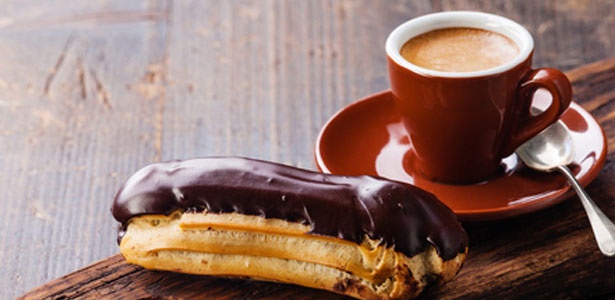The French word éclair means “in a flash of lightening” because that is how quickly these babies go down. The perfect éclair is crisp on the outside, filled with a cloud of whipped cream or custard and drizzled with fondant icing or chocolate ganache.
The pastry used to make these tidbits, is another example of French word play. The word choux means cabbage, and it is so called because a profiterole (a round piped puff of choux pastry) resembles a cabbage.
The choux pastry contains no sugar or raising agent, and only puffs up because of the high water content turning to steam. The basic mixture contains only water, butter, flour and egg.
Top tip
Measure butter by volume (in cups or ml) WITHOUT melting it first, use Archimedes’ Principle of Displacement. Pour cold water into a measuring jug (e.g. 200ml) then add the solid butter and push it below the surface of the water. When the water level goes up to 300ml (for example) you have measured 100ml of butter.
Putting the roux in choux
The first step to making choux pastry is to melt the butter with the water and then adding the flour off the heat. This is called the roux (a term that is more commonly used to describe the butter and flour in a white sauce). Once the flour is all mixed in, place the pot back on the heat to cook the flour a bit. Stir the pot constantly while it is on the heat. You will know it is done when the paste comes away from the sides of the pot. The word roux actually means red or red-brown, and refers to a browned butter.
Cool your roux
Do not add any eggs to the roux until it has cooled to the point that you can comfortably hold the pot in your hands. If the roux is hot, the eggs will curdle as soon as they are added.
Adding the eggs and beating
Add the eggs one at a time, beating well with a wooden spoon between each addition. The recipe calls for 4 eggs or 250ml of egg, because the sizes of eggs vary so much it is safer to measure the eggs out into a measuring cup before adding them. After each addition of egg, check the consistency of the paste. It still needs to have a “pipe-able” consistency, and it should keep its shape when piped. Do not let your mixture become too runny, you may not even need to add the full quantity of eggs, play it by ear. The beating can be done with an electric mixer, but make sure you check the consistency regularly.
Piping your éclairs
Pipe the éclairs onto a cookie sheet lined with a non-stick mat or prepared with cooking spray and a light dusting of flour. Pipe them out with a plain or open star nozzle about 10-15cm in length. When filling your piping bag turn the top of the bag over (like you would with the tops of your socks) to ensure that the opening of the bag stays (relatively) clean. Don’t overfill your bags (no more than half full) or they will tend to leak out the back of the bag.
Make a splash
Before you place the tray in the oven give the whole thing a splash with water (just using your hands) as the steam will help the éclairs to crisp up on the outside.
Baking the éclairs
Bake the pastries for 20 – 25 minutes in a hot oven (200°C) oven. They should be golden and crisp. Beware of taking them out of the oven too soon or they could flop down if they haven’t finished crisping. Once removed from the oven poke a hole in each one to allow steam to escape and place them back in the oven for an additional 3-5 minutes to crisp.
Fillings and toppings
The traditional fillings are whipped cream or crème patisserie and the traditional toppings are fondant icing (like on a doughnut) or chocolate ganache, but be adventurous with your toppings and fillings. Flavour your cream or custard for a bit of variety, and try different toppings, like sprinkled chopped nuts etc. All of the creamy, sweet taste of an éclair comes from the filling and the topping – as the pastry itself is fairly bland. So go crazy!
ALSO READ:
How to make the perfect meringues
How to make the perfect cupcakes

